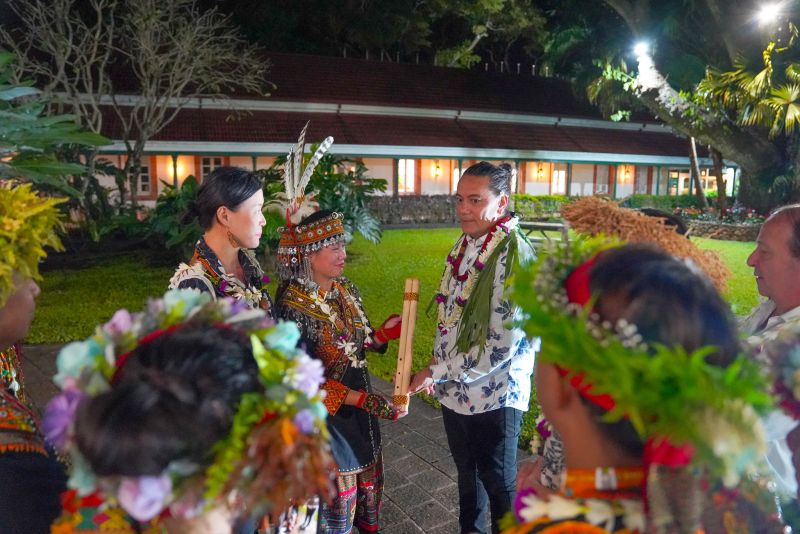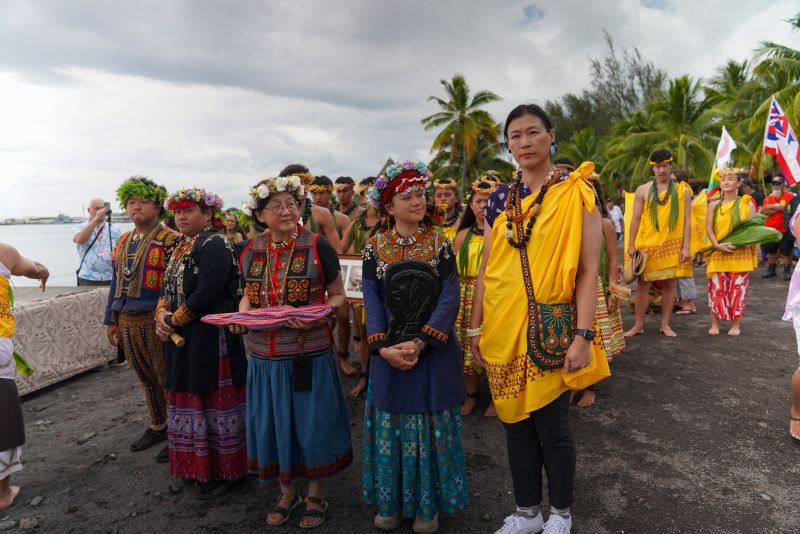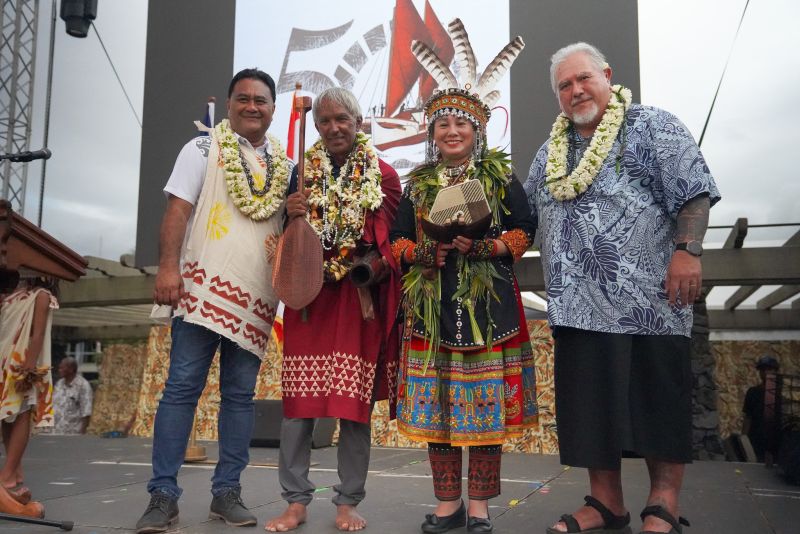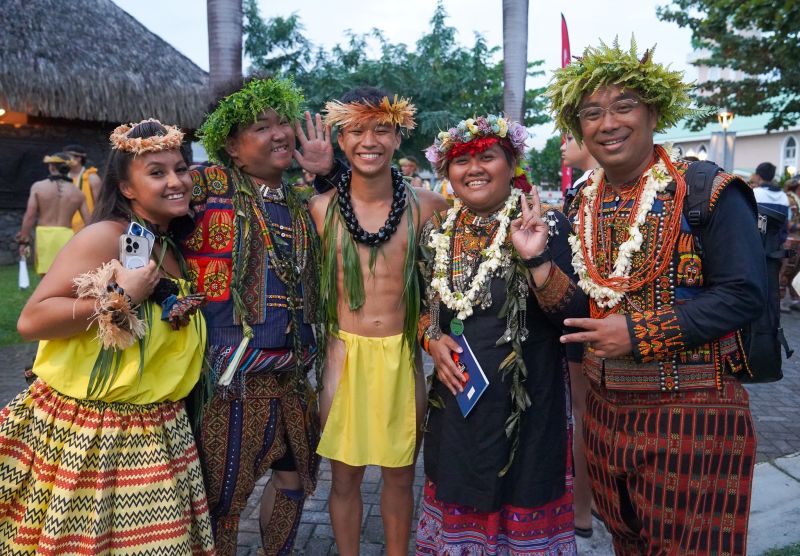Digital Collections
Celebrating the breadth and depth of Hawaiian knowledge. Amplifying Pacific voices of resiliency and hope. Recording the wisdom of past and present to help shape our future.
Kaʻiwakīloumoku Pacific Indigenous Institute
Kauwela 2025
In 2020, Kamehameha Schools established two cultural-educational partnerships in Taiwan: one with the Anthropology Department of the National Taiwan University (ranked among the top 75 universities in the world), and the other with the Paiwan Tribe of Kaviyangan in Pingtung. To better understand the significance of these historical connections, we need to delve more deeply into the history of this extraordinary ancestral Pacific homeland.
When we think of Taiwan and its people, images of Chinese culture come to mind. This is largely due to the dominant occupation of Han Chinese who began migrating to Taiwan from China some 400 years ago and now represent over 95% of the island’s 23 million people. What many do not know is that Taiwan was first discovered and settled by indigenous peoples some 6,000 years ago. This predates the invention of cuneiform writing in Sumeria (3200 BCE), the construction of the first pyramids in Egypt (2600 BCE), and the first historically recognized Chinese dynasty (1600 BCE).
In virtual isolation over the course of some six millennia, multiple indigenous tribes with unique cultural traits evolved independently across a dramatic biodiverse landscape. Their respective languages, though distinct, form an aggregate language category which linguists refer to as “Austronesian,” an ancient language family from which ʻōlelo Hawaiʻi is derived. Hawaiians, Tahitians, Māori, and other Polynesians represent the very youngest branches of this very ancient language tree.
Early Austronesian speakers developed sophisticated celestial navigation and maritime technology that enabled two-way voyaging across long distances. This led to the development of vast trading networks and facilitated migration and settlement as far west as Madagascar off the African coast; down through Island Southeast Asia into parts of Melanesia and throughout Micronesia; and radiating out into Western and Eastern Polynesia to Hawaiʻi in the north, Rapa Nui in the southeast, and finally Aotearoa to the far south. As they voyaged, they left genetic, botanical, cultural and linguistic imprints forming a 6,000-year-old genealogical road map illustrating profound human dispersal of epic proportions. Hōkūleʻa, Hikianalia, and the Moananuiākea Voyage are the embodiment of this vibrant, living Austronesian legacy of ancestral language, traditional navigation, and the peopling of the Pacific which NASA has recognized as among the greatest achievements of humankind.
On June 10, 2020 , undaunted by the global COVID-19 pandemic, Kamehameha Schools’ Kaʻiwakīloumoku Pacific Indigenous Institute reached out to the Zingrur Royal Family of Kaviyangan Village, a Paiwan tribal community located in the southernmost county of Taiwan, Pingtung. As the world was on lockdown, we agreed to conduct a traditional ceremony together using Zoom. The Paiwan played a double-piped nose flute, which was used to call their ancestors to join in the cyber-connection. We responded with the sounding of the pū and offered a mele dedicated to Ke Aliʻi Bernice Pauahi Bishop. As the Paiwan prepared their millet wine in a ceremonial double-cup vessel, we strained ʻawa and prepared an ʻapu, and together, we drank our traditional drinks to ratify a declaration of kinship which was read in Paiwan and ʻōlelo Hawaiʻi. Both parties then signed the agreement online, giving birth to the Kaviyangan-Kamehameha Schools partnership.
Much has happened over the last 5 years: In July 2021, the Paiwan dedicated a ceramic pot to Kamehameha Schools. They broke off a piece from the lip of the pottery and sent it to Hawaiʻi, so that it could be presented and reconnected with the original vessel as a way to identify ourselves as family when we come to visit in person in the future. In June of 2023, Princess Maljevljev and tribal members were invited to offer an ancestral blessing for the Hōkūleʻa at the global launch of the Moananuiākea Voyage in Juneau, Alaska. A year later in June 2024, the Kaviyangan Paiwan were hosted by Kamehameha Schools as guests to the 13th Festival of Pacific Arts and Culture. Some 300 Indigenous Taiwanese representing over eight different tribes were hosted at a lūʻau at Kaʻiwakīloumoku as they interacted with Hawaiian, Tahitian, Cook Islands, and Rapa Nui delegations through song and dance. A month later, in July of 2024, Kamehameha Schools was invited to be the featured performers at the prestigious Austronesian Joint Harvest Festival in Hualien for an audience of over 15,000 Indigenous Taiwanese. As part of that trip, Kamehameha students and staff were finally able to visit our Paiwan family in their home village of Kaviyangan and honor the Zingrur Royal Family who have been leading their tribe for 19 generations.
This past June, Hōkūleʻa and Hikianalia relaunched the Moananuiākea Voyage by sailing on our ancestral sea road, Kealaikahiki, to one of the most revered sacred sites in Polynesia, Marae Taputapuātea in Raʻiātea. Joining Kamehameha Schools onshore for welcoming protocols was Princess Zuljzulj and a small village retinue from Kaviyangan. Facing the east, they burned millet (an important grain used for flour and wine) to produce smoke to attract the ancestors, and they intoned their double-pipe flute. As a special gift to Mayor Thomas Moutame and marae elder Papa Maraehau Tavaearii, they presented a square tile with designs that came from their ancestral house located deep in the forest of sacred Dawu Mountain. They made this same offering in Tahiti to French Polynesian President Moetai Brotherson as Hōkūleʻa and Hikianalia made landfall at Hōkūleʻa Beach and engaged in a formal ceremony at Pāʻōfaʻi at the Papeʻete waterfront. The French Polynesian government and the Tahitian community as a whole are very aware of the ancient Austronesian language and seafaring heritage that we all share with Taiwan. But they did not expect that a princess, a high chiefess of stature from our Austronesian homeland, would be there in full regalia, honoring them with ceremonial protocol. It was a very moving and emotional experience for everyone.
Kamehameha Schools’ commitment to E Ola!-driven culture-based education sets the stage for broader and deeper interactions and engagements throughout our Pacific homeland in the years to come. Cultural-educational partnerships established through formal declarations signed and endorsed by CEO Jack Wong, and Executive Culture Officer, Dr. Randie Fong, and co-signed by traditional and governmental leaders from throughout the Pacific are clearly acts of self-determination — they are testimony to our collective dedication to promote ancestral knowledge and sciences, strengthen native identity and worldviews, and promote understanding and awareness of our rich Polynesian-Pacific heritage by actively engaging with our ʻohana throughout Moananuiākea.


The Taiwan delegation headed by Princess Zuljzulj of the Kaviyangan Paiwan Tribe, KS Pacific partners since 2020.

Princess Zuljzulj gifting a double-piped nose flute to Fabien Mara Dinard, Director of the Artistic Conservatory of French Polynesia TE FARE UPA RAU.

The Taiwan delegation waiting for the arrival of Hōkūleʻa and Hikianalia in Papeʻete, Tahiti.

(Left to Right) Minister of Education and Culture of French Polynesia Ronny Teriipaia, Pwo Navigator Nainoa Thompson, Princess Zuljzulj of the Kaviyangan Paiwan, and French Polynesian President Moetai Brotherson posing for pictures after exchanging gifts.

KSK Alumni Kamalei Sataraka (ʻ25) and Noah Samson (ʻ25) posing with members of the Taiwan Delegation after Hōkūleʻaʻs arrival in Papeʻete, Tahiti.